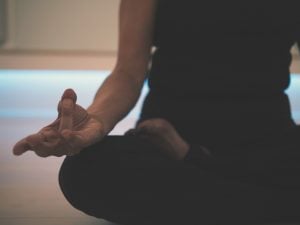The Science of Meditation

Chapter 1
It is undeniable that peace of mind is hard to come by these days especially since everything went in shambles due to the COVID-19 breakout. It is now more important than ever that we can learn the skill of controlling our emotions and negative thoughts. Experts in the field have recommended that exercise and meditation through mindfulness-based stress reduction are the ways to go.
Most of us are familiar with exercising but mindfulness meditation training is a different ballgame. It doesn’t require us to stretch our body muscles but instead trains and strengthens our brain’s flexibility and agility. But how does this “brain training” work? Have you ever wondered what’s the scientific explanation of meditation? In this article, we will delve deep into the mind and the science of meditation.
What is Mindfulness Meditation?

If physical exercise is for the body, meditation on the other hand is for the brain.
Meditation is the training of the mind to achieve a healthy sense of perspective and concentration. This practice coaches us to observe and understand our feelings, emotions, and thoughts rather than shutting them off. Training the mind leads to an improved presence of mind and attentiveness. Just like writing, meditation is also a skill you acquire through time and constant practice.
Studies have shown that meditation not only does wonders for psychological aspects but also the physical brain. Researchers verify that long-term meditators have significantly more gray matter volume in the brain compared to those who do not meditate.
A quick and shallow dive into the anatomy of the brain, it is made up of two kinds of tissues; white matter and grey matter. The grey matter covers regions of the brain that are responsible for muscle control and sensory perception. As we age, the volume of the grey matter decreases considerably. But if you meditate, your chances of losing volume in the grey matter are low.
How should we do our mindfulness meditation training?

With plenty of methods for meditating, you’ll surely find the right one for you.
Before we delve into the science of meditation, there are many techniques in meditating which we’ll get to in a moment. But first, let’s tackle the basics of meditating in general. There are three things you’ll need to consider:
● Location
● Mindset
● Expectations
Let’s begin with location. The answer is you can meditate anywhere. But if you are just beginning, it’s ideal that you go to a silent room where no one can disturb you. You might want to consider investing in a luxury property that can offer you exclusivity and easy access to nature. The goal here is to lessen outside interference while you meditate.
A lot of first-timers find it odd and uncomfortable to sit still and be alone with their thoughts. They find themselves wandering just a few minutes after starting. But that is all part of the training. If you are a novice, this is normal! Just like when you are working out, you feel the burn in your muscles because they haven’t been stretched to that extent.
The same goes with meditating, you are just starting to train your brain to reflect and concentrate. If your mind wanders, acknowledge it and try to concentrate better in your next session.
Moving onto mindset, it is important to wind down first if you just came home from a stressful day. Take a few moments to wind down before proceeding because if you push yourself immediately, you’ll find yourself distracted and discombobulated. It’ll be counterproductive.
Lastly, you need to ditch your expectations of what meditating is. You’ll only know what meditating is like once you surrender yourself to the experience. Forget about what your friend shared about meditation, whether it was a good or bad experience. Everyone has different experiences. Once you let go of your expectations, you’ll find the experience much more worthwhile and effective. This is all part of the science of meditation.
What are different ways to do mindfulness-based stress reduction?

With plenty of meditation techniques, you’ll surely find the right one for you.
As previously mentioned, there are many mindfulness training meditations techniques. But for the sake of readability, let’ discuss the top five techniques of meditation you can try.
● Mindfulness meditation
● Body Scan meditation
● Walking meditation
● Self-compassion meditation
● Transcendental meditation
Let’s begin with the most common and easiest technique for meditative practice which is mindfulness meditation. Mindfulness meditation trains us to recognize our thoughts and emotions at the moment. It is human nature to overthink the past and over plan the future. Mindfulness meditation encourages us to reflect on the present.
When practicing mindfulness, you will become more conscious of what is happening in the body and mind now. According to research, constant mindfulness meditation can teach us how to eliminate avoidance in our lives and embrace changes and hardships that come our way. We might also need mindfulness-based cognitive therapy.
Moving on to the next, we take on Body Scan meditation. From the name itself, we already have a good idea of what it’s about. The science of meditation works here as stress manifests in many ways and one of those is physical discomfort. Body scan meditation is one of the ways to check in on our bodies.
As you close your eyes and do your breathing exercises, your main focus should be how your body is feeling at the moment. Analyze each part of your body. Take note of what aches and what doesn’t. This practice will enlighten you about every part of your body and will assess which parts need attention or care.
These top two techniques of meditation are known to enhance overall psychological well-being.
The third on our list is for those who find it difficult to meditate while seated. Walking meditation focuses on the sensationsin your feet. Some people find it easier to concentrate when in motion. A tip you can do while walking meditating is to create a mental image of a line, whether it’d be a straight line or a dotted line. Breathe as you normally would while walking and keep your arms in the most comfortable position you prefer.
While walking, focus on the sensations on your feet. Make sure you complete a step before you start lifting your other foot. After walking in a straight line, walk back to where you came from. If your mind wanders while you do this, it’s okay. Just take note of it and bring your concentration back to your feet. There is no set speed for this as long as you don’t look like brisk walking!
The fourth on our list is self-compassion meditation. Also known as loving-kindness meditation, this technique aims to bolster our ability to connect, accept and forgive others and ourselves. This is all easier said than done because admittedly, we have a tendency to be hard on others and even on ourselves.
This technique traces its roots in Buddhism and has plenty of ways you can practice it. This simple but effective technique can get you started. The science of meditation begins once you find a quiet place and find a comfortable place to sit. Close your eyes and take deep breaths. Once you feel relaxed, start muttering words of affirmation towards yourself. This can be done mentally and no need to recite them out loud.
When you inhale, imagine taking in all the positive affirmations you are mentally reciting. In the same vein, imagine releasing negative energy and toxicity as you exhale. After this, wallow yourself in the loving bubble you’ve created. Then you can proceed to redirect the same energy to your loved ones. Extend these feelings of love, gratefulness, and gratitude to them as you did to yourself.
The last but not the least technique is Transcendental meditation. This is the method where you sit comfortably with your eyes closed and silently recite a mantra. A lot of newbies get intimidated by this method because of the uneasiness that comes with sitting still. The function of the mantra is to entice us to focus and achieve the state of perfect stillness.
Transcendental meditation is usually guided by an instructor. Since we are still in the middle of a pandemic, you can venture into meditation apps instead. Take advantage of the deluge of options made available online. While there are free apps you can also opt for the paid ones if you prefer premium sessions.
Why does meditation work on our mental health?
What makes meditation work? Let’s take a shallow dive into what makes it an effective tool for people. According to a psychotherapist consulted by HuffPost, one develops “mental strength” which promotes heightened resiliency, efficiency, and emotional.
Another interesting fact about meditation is its ability to surpass the effects of antidepressants for depression and anxiety. Studies have shown that meditation increases the effect size of the brain to 0.3, the same as antidepressants. Although meditation is not a clear-cut antidote to depression, it can for sure manage the symptoms.
Anchored to this is meditation’s ability to reduce anxiety. Researchers discovered that meditation also helps people who have a social anxiety disorder. The breathing exercises also help in stress-induced anxiety. It’s time to debunk the myth that meditation is just another passive activity. It is an active training of the mind and this training boosts concentration and lengthens attention span.
Oneness with nature mental health benefits
Meditation is a treasure. Tracing its beginnings with religions such as Buddhism, Christianity, and many more, this practice has helped many individuals since time immemorial. Meditation is good for everyone who wants to improve their concentration and focus. It is also key if you want to have a deeper understanding of yourself and others.
Meditation is not only just sitting silently with your eyes closed. You are training it to avoid distractions and focus on reflecting on the present. Long-time meditators claim meditation makes them feel like gold.
Match this feeling of magnificence with a luxury home or luxury condo. Here at Brittany Corporation, we only give the best for our clients. Since location is a big consideration when you meditate, you should consider investing in a luxury house that can give you the peace and quiet you need every time you have a meditation session.
If you’re the type who enjoys meditating, for sure you appreciate tranquility and being surrounded by nature. Promenade by Brittany is the place to be because of its abundant greenery and biodiversity.
Visit Brittany’s official property page to know more about Brittany’s beautiful thematic offerings or follow us on our Linkedin, Facebook, Twitter, and Instagram accounts!
If you want us to feature your article or product, inquire about digital partnerships, or propose backlink opportunities, send us an email at digital@brittany.com.ph.